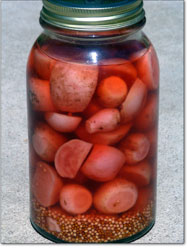| ||
A different kind of hot by Chef Boy Ari It’s time to play “Ask Dr. Chef Boy Ari.” So let’s ask Dr. Chef Boy Ari... Dear Chef, Every summer, I choose a vegetable that I don’t really get along with, and I make a good-faith attempt to love it. Last year it was beets, and I made grand progress (thanks in part to your nice article on pickled beets).Well, this is my year for radishes. They look so bright and beckoning at the Farmer’s Market – especially early in the season, when there’s nothing else to buy. But all I ever do is munch a few raw and slice the rest into salad, while the rest lie forgotten in the back of my fridge. I feel like I’m stuck on the surface, but I don’t know how to dive in further. What can I do? – Floater Dear Floater, The radical tuber with the fiery disposition can be employed with surprising range, provided you understand a few key aspects of radish nature. First of all, radishes can be superficially grouped with peppers in that they impart a flavor that is often described as “hot.” Although there are significant chemical and behavioral differences between peppers and radishes, the analogy holds in that if all one ever did with hot peppers was munch a few raw and slice the rest on salads, one would indeed be stalled upon the surface of a large ocean of possibilities. Interestingly, both radish and pepper are associated with chemical weapons. The oleoresin capsicum in peppers is the active ingredient in pepper spray. Meanwhile, the active flavor component of the radish (as well as that of mustard, broccoli, watercress, cabbage and the whole army of cabbage family members) is a chemical group called isothiocyanates – commonly thought to be the active ingredient in the infamous mustard gas. While the link between the cabbage family and mustard gas is a myth, it was so prevalent that for a time it was illegal to import mustard oil into the U.S. Digging a little deeper, we find that although both peppers and radishes are described as “hot,” the kick of the radish is very different from that of the pepper. Pepper heat stays around the mouth (while causing the entire upper body to sweat) and continues to creep hotter and hotter — despite all attempts to put out the flames. Radish heat goes straight to your head, evacuates your sinuses and then quickly vanishes. Almost everything I know about radishes I learned from Asian cuisine. In this context, my favorite preparation is the Japanese green radish paste called wasabi – an essential component of the sushi experience.
Almost everything I know about radishes I learned from Asian cuisine. In this context, my favorite preparation is the Japanese green radish paste called wasabi – an essential component of the sushi experience. Last year I went to South Asia, where I visited Bhutan and Thailand, the cuisines of which expanded my radish-sphere considerably. In Bhutan, for example, there is a popular dish called phagsha pa, in which radishes are stewed slowly with pork. To really be authentic, phagsha pa should be cooked in mustard oil, which can be found in Indian grocery stores, or ordered over the internet. Remember: when cooking with mustard oil, first heat it a few minutes alone in the pan until it smokes – a procedure the Bhutanese call “smoking the oil.” (If you can’t get mustard oil, heat some high-frying oil like grapeseed oil at medium heat, and add some mustard seeds.) Then add chopped bacon or other pork product – ideally, natural or organic, because factory hog farms are disgusting. When your pork product is frying in the oil, add some sliced radish, chopped onion and hot peppers, and a bit of water so it starts to steam, and put a lid on the pan so the steam can build up some pressure. Stir it and stew it, adding water if necessary, until it all comes together. Season with soy sauce and vinegar, and serve over rice. Take-home message: cooking radishes mellows and sweetens them, and the mellowed radish flavor is transferred to the other ingredients. A few weeks later, while decompressing on the beach in Thailand, I was thrilled to realize that the fried noodle dish known as pad thai – one of my favorite Thai dishes – incorporates pickled radishes. To make pad thai, begin by cooking, straining and rinsing rice noodles. Then heat some oil in a wok with chopped garlic. Add chopped tofu and chopped, pickled radish. After it starts to simmer and flavo-merge, pour in some beaten eggs. When the eggs start to set up, add soy sauce, stir it all around, and stir in the noodles – with some tamarind sauce (tamarind paste mixed with sugar) if you’ve got it. Add bean sprouts, chives and ground peanuts. Remove from heat and garnish with more bean sprouts, chives, ground peanuts and a slice or two of lime. Take-home message: Pickled radishes are a great way to begin a stir-fry. Other take home message: It’ll soon be time to pickle radishes. I pickle my radishes in halves and quarters in a 50/50 mix of water and cider vinegar, sweetened to taste. To each quart jar, I add a few dried bird’s-eye chili peppers, two tablespoons of mustard seeds and a teaspoon of salt. By the way, Floater ... when you are washing those radishes before you pickle them, do so in a tub of water. The ones that float to the surface (the floaters, as it were) should be discarded, as they are not so dense inside and won’t stay crispy. Take-home message: Dive in! – Yours truly, Dr. Chef Boy Ari •
|


